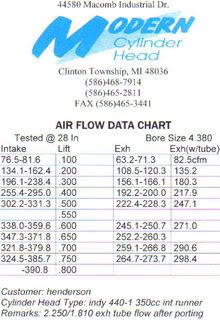fishy68
Tyr Fryr's Inc.
I've seen flow numbers posted for various heads on a few different sites. Sometimes I see it state "without exhaust pipe" and "with pipe" and without the pipe the numbers are lower. I can only assume that with no pipe it acts like the intake would with no guide to straighten the air. Is this true? If so is there any way to estimate how much difference there could be or is every head different? Reason I ask is when the guy flowed my heads that I ported he said the exhaust flow was a little weak compared to the intake. He didn't use any type of exhaust pipe on it though and after seeing the statement with and without pipe I'm wondering if the flow numbers might actually be better than what he said they were.

















